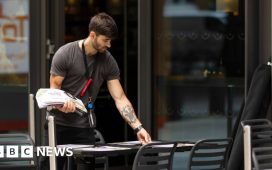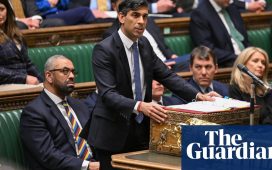No 10 is facing criticism after a day of widespread confusion over its coronavirus lockdown advice, with a lack of clarity about who is allowed to travel to work, whether couples who live apart can still see each other and what counts as exercise.
Ministers had to give further guidance on a raft of different scenarios, after people expressed worries about what they were allowed to do and who they could still see.
The biggest confusion occurred over workers still travelling in packed tube trains to non-essential jobs, such as construction, with employees complaining they were being forced to work despite feeling unsafe.
Nicola Sturgeon, the Scottish first minister, and Sadiq Khan, the London mayor, said construction workers should not be attending their workplaces.
However, the government overruled them, saying employers could still require staff to attend their jobs in person – even though the overarching guidance is for people to “stay at home, where possible”.
Other areas of confusion included:
-
Advice over whether children of separated parents could still visit both households. Michael Gove, the Cabinet Office minister, initially said they could not, but quickly reversed his position to make clear that they could continue to live across two homes.
-
Whether tradespeople, such as plumbers and electricians, could still enter people’s homes. Gove said it was reasonable for them to attend emergencies.
-
What types of exercise were permitted. Gove said people would be allowed to run, walk or go to an allotment, but not to do more social activities, such as playing golf.
Despite Boris Johnson ordering the nation to stay at home on Monday night, images emerged for the second day running of travellers cramming on to London underground services during Tuesday morning’s rush hour.
The pictures prompted concern that the reduction of train services because up to 30% of transport staff were off sick had made it impossible for workers to maintain physical distancing on their commutes.
In a clash between Downing Street and City Hall, Khan accused the government of refusing to take difficult decisions, while Matt Hancock, the health secretary, argued the tube should be running in full to prevent overcrowding.
The health secretary used No 10’s daily press conference to criticise the London mayor – who is chair of Transport for London – by saying more trains should be laid on for passengers.
Hancock said: “When it comes to the tube, the first and the best answer is that Transport for London [TfL] should have the tube running in full so that people travelling on the tube are spaced out and can be further apart – obeying the two-metre rule wherever possible.
“And there is no good reason in the information that I’ve seen that the current levels of tube provision should be as low as they are. We should have more tube trains running.”
A spokesman for Khan said Hancock’s claim was “simply not true”. He said: “The mayor has told ministers countless times over recent days that TfL simply cannot safely run a full service because of the levels of staff sickness and self-isolation. Nearly a third of staff are already absent – there aren’t enough drivers and control staff to do it.
“The government must act urgently to get more people staying at home rather than going to work unnecessarily – that means taking the difficult decisions they are refusing to take to ban non-essential construction work and provide proper financial support to freelancers, the self-employed and those on zero-hours contracts to stay at home.”
The British Transport Police said on Monday that its officers would be “on hand to support rail operators if people are clearly disregarding the advice”. New police powers to enforce the lockdown, including the ability to impose on-the-spot fines, are expected to come into force on Thursday. The force said it would provide a “high-visibility presence” and advice in the meantime.
TfL has suspended the Circle line and the Waterloo and City line, as well as running reduced services on other parts of the network, with about 40 stations closed. Bus services have also been cut.
The number of journeys on the tube – of which there are normally nearly 5m a day – have been down 85% on Monday and Tuesday, according to TfL. Transport for Greater Manchester is also running reduced tram, train and bus services with figures showing usage down between 70% and 80% compared with normal levels.
People in other areas of the country appeared to be broadly following the government’s strict instructions that people should only leave the house for select reasons such as shopping for essential supplies or once-a-day exercise.
In Bristol, shops from hair salons to fashion stores in the city and suburbs were closed. Most city-centre offices were deserted save for security guards. Buses were empty or carried only a few passengers. Supermarkets, from giants such as Tesco to local Polish and Chinese stores, were allowing only a restricted number of shoppers in at once.
For the most part, people were keeping two metres apart as they waited their turn in queues. People waiting for cashpoints also kept more of a distance than normal. The Princes Pantry cafe at the harbour asked people to order and wait outside.
There were exceptions. Builders working on sites in the Temple Quarter and around Castle Park laboured side by side. A hand carwash in St Paul’s remained open. Thatchers working on a cottage on the outskirts of Bristol continued to work. A few people could not resist gathering in small groups in some parks.

In Marple, a small town on the edge of Stockport, streets were largely empty aside from a small number of people queuing outside Boots, fully observing the two-metre distancing guidance.
Notices filled most shop windows informing the public of the sudden closure with most saying they would hope to reopen soon but were following government advice. Another sign, in the window of the Hound Dog Grooming Spa, said they would be posting tutorial videos on social media over the coming weeks to help customers’ keep their dogs in “tip top condition”.
Even London, with rush hour over, had the air of an abandoned city. Shops were shuttered and high streets were devoid of nearly all human activity bar an occasional Deliveroo courier, jogger or cyclist taking their permitted single bout of exercise, an occasional work van and almost empty buses.
Piccadilly Circus, normally a hotspot for spring tourists, was deserted while the solitary shop still open in Old Bond Street was preparing for closure later in the day. The South Bank, another hugely popular promenade, was deserted. With the London Eye, Royal Festival Hall and the National Theatre all ordered to close, the only sound was the squawks of gulls.














